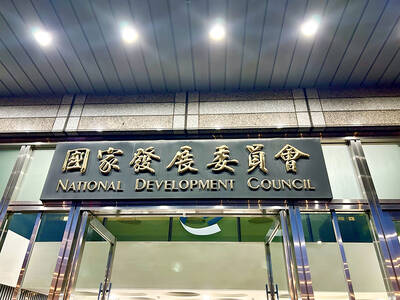Captain Mineo Hirata and the 280 sailors on board the Japanese navy destroyer JS Kongo will attempt to shoot a ballistic missile out of space today -- a first for Tokyo or any US ally.
The joint Japan-US test off Hawaii comes almost 10 years after North Korea launched a long-range missile that flew over Japanese territory and splashed into the Pacific Ocean, spurring an alarmed Tokyo to invest billions in missile defense.
"There are countries near us that possess ballistic missiles," Hirata told reporters on a Pearl Harbor pier before the Kongo headed out to sea. "This [the test] is very important for the defense of our nation, for the protection of our people and property."
Experts say the test of the Standard Missile-3 interceptor will likely strengthen the US-Japan defense alliance.
But it may also deepen concerns in Beijing that Tokyo could use the technology to help the US defend Taiwan if conflict erupted across the strait.
The Pacific Missile Range Facility on Kauai, run by the US Navy, will fire the target missile into the sky. The USS Lake Erie, a Pearl Harbor-based guided missile cruiser, will track the missile target and feed information on it to a command center.
The medium-range test target is expected to resemble Pyongyang's Rodong missiles, which are capable of flying about 1,000km -- or far enough to put Tokyo and much of Japan within their range.
The Rodong has a shorter range than the Taepodong-1 missile that flew over Japan in 1998.
But the Rodong, of which North Korea is believed to possess about 200, represents the biggest security threat to Japan, said retired vice admiral Fumio Ota, the director of the Center for Security and Crisis Management Education at the National Defense Academy of Japan.
"If we have midcourse missile destruction capability, we would significantly improve our missile defenses," said Ota, a former director of Japan's defense intelligence headquarters.
US Navy ships have successfully intercepted medium-range ballistic missiles in space in previous tests.
Today's drill will see if Japan can do similarly, even though the AEGIS ballistic missile defense system it has on board has been modified slightly to suit Japanese ship specifications.
Bruce Bennett, a senior defense analyst at the RAND Corp, said that even if the Kongo succeeds, it will be a couple of years before Japan installs enough missile interceptors on board its ships to substantially boost its capabilities.
Ota said the test would bolster a US-Japan alliance that has suffered from two recent setbacks.
One involves allegations that a Japanese lieutenant commander leaked classified data involving the AEGIS system. Police arrested the officer on Thursday.
The other is Tokyo's suspension of a program to refuel US ships supporting coalition forces fighting in Afghanistan, Ota said. Japan had to end the refueling mission when the government failed to win enough opposition votes for a bill that would have extended the program.

RESPONSE: The transit sends a message that China’s alignment with other countries would not deter the West from defending freedom of navigation, an academic said Canadian frigate the Ville de Quebec and Australian guided-missile destroyer the Brisbane transited the Taiwan Strait yesterday morning, the first time the two nations have conducted a joint freedom of navigation operation. The Canadian and Australian militaries did not immediately respond to requests for comment. The Ministry of National Defense declined to confirm the passage, saying only that Taiwan’s armed forces had deployed surveillance and reconnaissance assets, along with warships and combat aircraft, to safeguard security across the Strait. The two vessels were observed transiting northward along the eastern side of the Taiwan Strait’s median line, with Japan being their most likely destination,

GLOBAL ISSUE: If China annexes Taiwan, ‘it will not stop its expansion there, as it only becomes stronger and has more force to expand further,’ the president said China’s military and diplomatic expansion is not a sole issue for Taiwan, but one that risks world peace, President William Lai (賴清德) said yesterday, adding that Taiwan would stand with the alliance of democratic countries to preserve peace through deterrence. Lai made the remark in an exclusive interview with the Chinese-language Liberty Times (sister paper of the Taipei Times). “China is strategically pushing forward to change the international order,” Lai said, adding that China established the Asia Infrastructure Investment Bank, launched the Belt and Road Initiative, and pushed for yuan internationalization, because it wants to replace the democratic rules-based international

The National Development Council (NDC) yesterday unveiled details of new regulations that ease restrictions on foreigners working or living in Taiwan, as part of a bid to attract skilled workers from abroad. The regulations, which could go into effect in the first quarter of next year, stem from amendments to the Act for the Recruitment and Employment of Foreign Professionals (外國專業人才延攬及僱用法) passed by lawmakers on Aug. 29. Students categorized as “overseas compatriots” would be allowed to stay and work in Taiwan in the two years after their graduation without obtaining additional permits, doing away with the evaluation process that is currently required,

RELEASED: Ko emerged from a courthouse before about 700 supporters, describing his year in custody as a period of ‘suffering’ and vowed to ‘not surrender’ Former Taiwan People’s Party (TPP) chairman Ko Wen-je (柯文哲) was released on NT$70 million (US$2.29 million) bail yesterday, bringing an end to his year-long incommunicado detention as he awaits trial on corruption charges. Under the conditions set by the Taipei District Court on Friday, Ko must remain at a registered address, wear a GPS-enabled ankle monitor and is prohibited from leaving the country. He is also barred from contacting codefendants or witnesses. After Ko’s wife, Peggy Chen (陳佩琪), posted bail, Ko was transported from the Taipei Detention Center to the Taipei District Court at 12:20pm, where he was fitted with the tracking